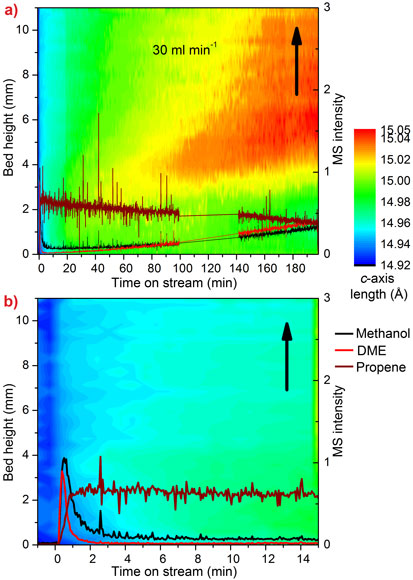- Home
- Industry
- Industry news
- In operando X-ray...
In operando X-ray diffraction studies on a catalytic reactor for the methanol-to-olefin process
31-08-2012
High-energy X-ray diffraction was used for time and space resolved in operando studies on the zeolite catalyst inside a working catalytic reactor for the methanol-to-olefin process. Scientists were able to correlate growth in size of the unit cell of the catalyst with its deactivation at different positions in the reactor.
Share
The Challenge
To follow the progress of the MTO reaction within a working reactor with particular focus on the changes with time of the zeolite catalyst.
Background
The methanol-to-olefin (MTO) process is becoming a key step in the route from inexpensive, plentiful and even renewable feeds like gas, coal and biomass, to the chemical building blocks we depend on every day. Olefins are a particularly useful group of chemicals which can be transformed into polymers used in anything from plastic bottles to thermal underwear. The catalyst in the MTO process is the porous zeotype SAPO-34, which suffers from deactivation caused by the build-up of coke in its zeolite cavities.
Synchrotron techniques
High-energy X-ray diffraction (HEXRD) at beamline ID15 was used to investigate the development and location of intermediates in the catalyst bed. The output from the reactor was analysed with a mass spectrometer.
Results
Diffraction patterns were collected every second as the reactor and heaters were translated through the X-ray beam. Each pattern was processed using parametric Rietveld methods (up to 500 datasets at a time) and c-axis expansion was plotted against time and position in the reactor. The resulting contour plots are shown in the figure below.
Early in the reaction we see that the initial expansion of the catalyst corresponds to an increase in the production of olefins, while the later deactivation of the reactor bed is correlated to the appearance of highly expanded regions of catalyst in the top section of the bed, caused by inactive coke. The point at which the expansion first appears is determined by the flow rate of methanol and the number of catalytic active sites.
How did the synchrotron experiment help?
The observed behaviour could be explained by a new kinetic model of the process. This model was the first to include the link between methanol feed and increasing coke levels. The knowledge gained will help to improve the efficiency of the MTO process at an industrial scale.
Industrial collaboration
Collaboration with SINTEF and Ineos Chlorvinyls (formerly Norsk Hydro) for investigation of the MTO process. The project is part of the inGAP (innovative natural gas products and processes) centre for research based innovation. inGAP brings together researchers from several major chemical companies with SINTEF, the university of Oslo and NTNU in Trondheim to develop technology related to natural gas processing.
Further information
D.S. Wragg, M.G. O’Brien, F.L. Bleken, M. Di Michiel, U. Olsbye, H. Fjellvåg, Watching the methanol-to-olefin process with time- and space-resolved high-energy operando X-ray diffraction, Angewandte Chemie International Edition 51, 7956–7959 (2012).
Top image: Sketch of the experiment. Diffraction patterns were collected every second as the reactor and heaters were translated through the X-ray beam.




